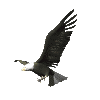
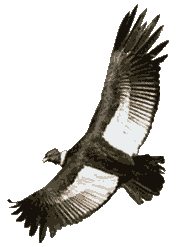


PERU ITINERARY
OCT. 5 - 18, 2003
![]()
Day 1 --- OCT. 5 ---Sunday
Fly into Lima, Peru
(airfare from USA is not included)
Arrive Lima Airport met upon arrival and transfer to hotel.
Evening "talking circle" sacred hoop circle to get
acquainted and share our intentions for our journey.
Overnight El Pardo Hotel, Miraflores
LIMA - PACHACAMAC - ICA
Day 2 --- OCT. 6 --- Monday
We begin our journey by motor coach excursion south
from Lima along the Pan American Highway to ancient
pre-Inca “Oracle“ of Pachacamac.
Pachacamac is one of the largest and most important
ceremonial centers,
overlooking the coastal desert of
central Peru.
Pilgrims came from many miles away to
consult the Oracle, one of the four major oracles that
existed within the Inca territory.
At this ancestral
sacred site we will meditate
upon our intentions for
our journey with a ceremony of gratitude
and ask for
direction and clarity from the
"Oracle Spirit of Place."
Lunch and on to Ica.
ICA, located between Paracas
and Nazca,
is a lush agricultural oasis surrounded
by desert sands.
The narrow desert fringe that
stretches for more than 1,400 miles along
Peru's Pacific Coast,
has been called the driest desert
on Earth.
Small oasis have formed where rivers,
descending from the slopes of the
Andes cross the desert.
Here, people have lived for
thousands of years.
Desert and sea, dry golden dunes,
crystal clear waters, mysterious and
enigmatic markings;
all this is Ica,
an oasis of contrasts and contradictory landscapes,
with myths and legends which relate
the rise and fall of peoples who persevered against
the hostility of the desert to construct their towns
and civilization.
Ica, land of cotton, wine and pisco,
a liquor with an aromatic,
grape bouquet, is full of history.
Ancient Peruvians of the area wove
splendid robes of varied colors;
mummified their dead with singular skill;
and drew lines and
gigantic figures in the desert as a homage to
the Sun, the Moon, the Earth and the Stars.
(BB, Lunch) Overnight LAS DUNAS HOTEL, ICA

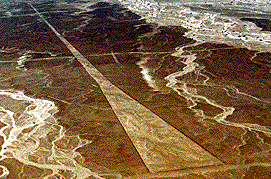
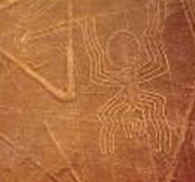
ICA - NAZCA LINES - PARACAS
Day 3 --- Oct. 7 --- Tuesday
Some 2,500 years ago, Nazca was the
seat of a pre-Inca civilization
highly advanced in both
astronomy and ceramic art.
Today enormous geoglyph figures of animals,
birds and geometric figures remain
etched in the desert,
a testimony to this remarkable culture.
The line drawings can only be seen
and appreciated from the air.
This morning we will fly over
the Nazca Lines,
stretching across the Nazca plains,
like a giant map or blueprint left
by ancient astronauts.
The Nazca Lines were first spotted when
commercial airlines began flying across
the Peruvian desert in the 1930's.
Passengers reported seeing
'primitive landing strips'
on the ground below.
Author Eric Von Daniken hypothesized that,
in remote times, ancient astronauts
visited the earth; and the giant figures
on the Nazca plain were meant as signals
for the space travelers,
as they touched down on 37-mile long airfield.
The Nazca Lines are known for 13 gigantic
animal figure constellations,
countless mathematically precise geometric patterns,
spirals, and 144 flat surface landing strips.
The entire area was made up of huge
iron ore deposits that concentrated
magnetic energy,
creating an electromagnetic field of
extraordinary strength.
As we fly over the energies of the Nazca Lines,
one can feel the connection that these
ancient people had with
extraterrestrial sources of guidance,
and the energies can awaken the remembrance
of that connection in us as well.
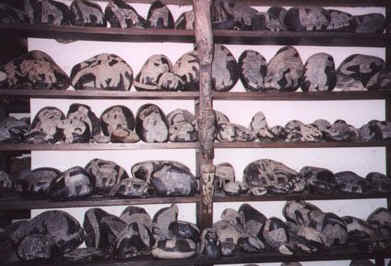
After lunch we will visit the museum of the Ica Stones .

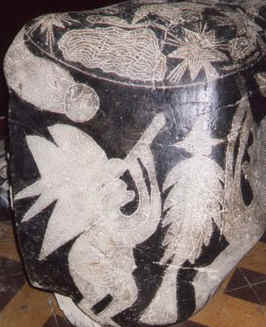
The collection of approximately
15,000 stones are the ancient carved
gliptolithic rock-
library known as the Ica Stones.
In the 1960's a farmer found
piles and piles of rocks deep in various
gorges and caves not far from the Nazca Lines.
The etchings reveals a lighter color than
the original dark varnish of age,
yet the etched grooves also bear
traces of this varnish,
indicating that the carving was done
in ancient times.
They are a form of andesite,
a gray to black volcanic rock,
and a very hard mineral that would make
etching quite difficult with primitive tools,
a local river rock,
covered with a patina of natural oxidation.
Laboratories in Germany have authenticated
the incisions that make up the carvings
as extremely ancient.
Dr. Cabrera's library
is organized by subject matter including
the races of man,
ancient animals,
lost continents,
and the knowledge of a global catastrophe.
We depart for coastal Paracas and
check in to our beautiful beach resort hotel.
This small coastal town was an important
trade center of the Paracas culture
that flourished over 3,000 years ago.
From around 1300 BC to 200 AD
the Paracas culture dominated the
barren desert,
south of Lima.
These people are considered to have
produced the finest textiles
known in the pre-Colombian period.
Evening group Star/UFO gazing
and Sacred Hoop Circle
to share our Nazca experiences.
(BB, Lunch) Overnight PARACAS HOTEL
![]()

~continue~
pictures of Ica Stones
compliments of "Dave"
http://members.cox.net/icastones/home.htm